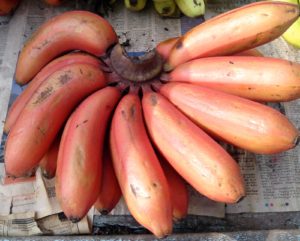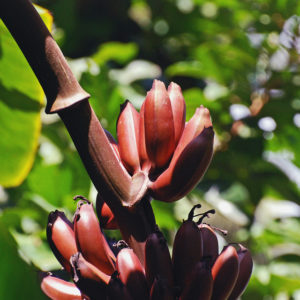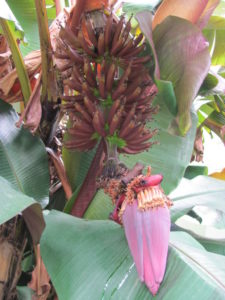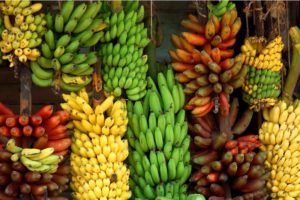A rare fruit in today’s markets, though it is said to be somewhat found at Parika market, is the red banana or what Guyanese call “buck banana” and “red buck banana”; “buck” being the derogatory local word for an indigenous person. The fruit has also been called “purple banana” and “Parika banana” here in Guyana.


To date there is no literature as to the etymology of the derogatory local name. Its official scientific name is “musa acuminate (AAA Group)”, belonging to the Cavendish group (AAA), a cultivar of the wild banana Musa acuminate.
It’s also known scientifically as several other names, including “Musa acuminate Colla (AAA Group) cv. ‘Red’”.
Some persons suggest that the banana is purple or rust coloured, not red. However, most scientists agree with its “red banana” description, though it does have a reddish-purple hue. From green, the skin starts off red and ripens to a deep purple colour. Some start to get hints of yellow in them as they ripen.
Walking around Georgetown markets reveals few vendors of the red bananas, with little certainty of a regular supplier. Its rarity has of course priced it higher than other banana types but no one can say for certain whether this is due solely to a lack of demand, or a lack of farmers who grow the red banana.
In Guyana there is neither evidence of official export of the red banana nor large scale cultivation of the fruit.
Across the world, red bananas come in varying shades of red, names and sizes. In Guyana it is described as being about the same size as the apple banana; there is the dwarf version (which is what we call the apple banana size) and its bigger counterpart – about the size of our cayenne bananas.
In Australia it is known as the Red Dacca banana; in various other regions it is known as the Red Spanish, Red Cuban, Colorado, Jamaican red banana, red Cavendish banana, or Lal kela, though its official English botanical name is Red Dacca.
The smaller type is known variously as Dwarf red and Dwarf Jamaican red also.
Red bananas are said to be native to India, where there are still wild species growing. Trade routes took them to the New World where Columbia and Ecuador are major South American exporters of the red banana today.
According to Lee Drummond in his paper “Structure and process in the interpretation of South American myth: The Arawak Dog Spirit People” (McGill University), the Guyana Arawak (Lokono) word for the red banana is ebiswadu.
It is called ebiswadu because it changes from green to red when ripe; biswana in Lokono means “changed” and refers to a person, while biswadu refers to a thing that changes in a dramatic way.
The Piro indigenous group in Peru has based one of their customs solely on the red banana. According to one source, celebrations consist of giving red bananas as gifts. Additionally, young males in the Piro tribe compete to climb the banana trees the fastest and reach the highest.
Their superstition revolves around the belief that each end of the banana contains a good side and a bad side. They believe that if you open a banana on the bad side you are inviting a bad omen into your life.
To avoid this, they have a culturally specific method to opening the banana. They twist the banana from the middle in order to negate the “bad” side of the banana. Most of us peel the bananas from either end.
For the Ese Ejja indigenous community in Northern Bolivia, red bananas are considered the most dangerous fruit. It is associated with witchcraft, and the most common method of sorcery is to put a red banana (hueshe huo’o in their language, or guineo morado in Bolivian Spanish) on the path of the victim to step on, so that sorcery enters his or her feet.
Once the victim steps on the banana, the person becomes ill and the only way of rescuing him or her is to cut the plant from which the banana came, to neutralise its eshahua, a common translation of Devil or spirit.
The Ese Ejja believe that animals and plants have eshahua and they can cause illness and death in humans, when they fail to observe the appropriate behaviour in relation to food.
Red bananas are considered to be low in calories and a good source of fibre and potassium. In addition, they are high in Vitamin B6 and a good source of vitamin C.
Generally speaking, bananas have been modified over the years by humans where it is said they have crossed two varieties of African wild bananas, the Musa acuminate and the Musa baalbisiana, got rid of the many seeds, and improved the flavour and texture to its present soft and sweet flavour.
The banana spread to Southeast Asia, and through trade routes spread to other parts of the world, including East Africa and South America. The rootstocks are said to have been packed onto a ship of Tomas de Berlanga, a Portuguese Franciscan monk, who brought them to the Caribbean island of Santo Domingo from the Canary Islands in 1516.
It is also said that de Berlanga may have met the bananas on the islands, introduced by Portuguese sailors from West Africa. It wasn’t long before the banana became popular throughout the Caribbean as well as Central America.
Arabian slave traders are credited with giving the banana its common name, from banan Arabic for finger – which were the size of the banana type. However, the Guinean word for banana is banema suggesting an alternative name origin. Some botanists believe the Spanish guineo morado hints at its Guinean origin.





